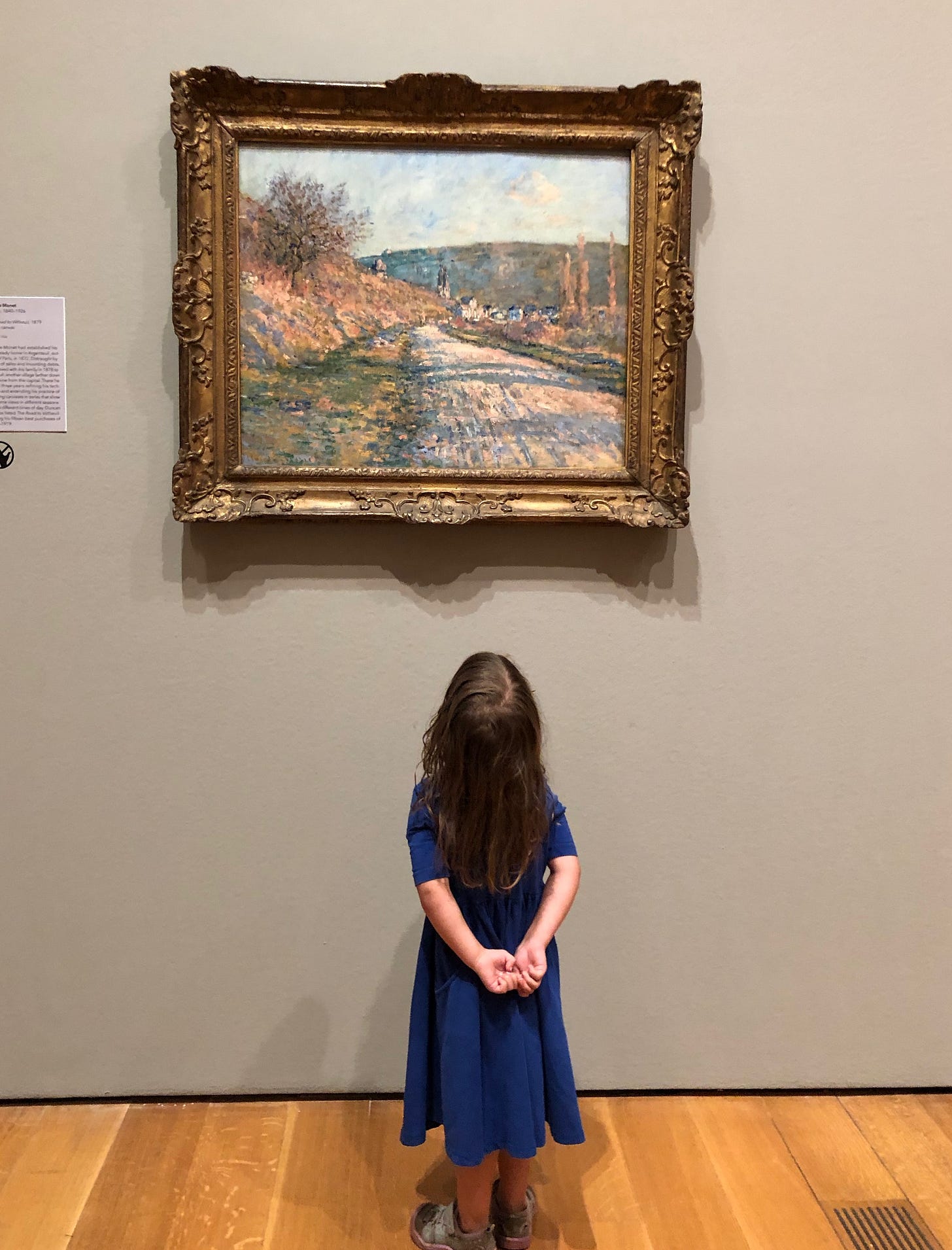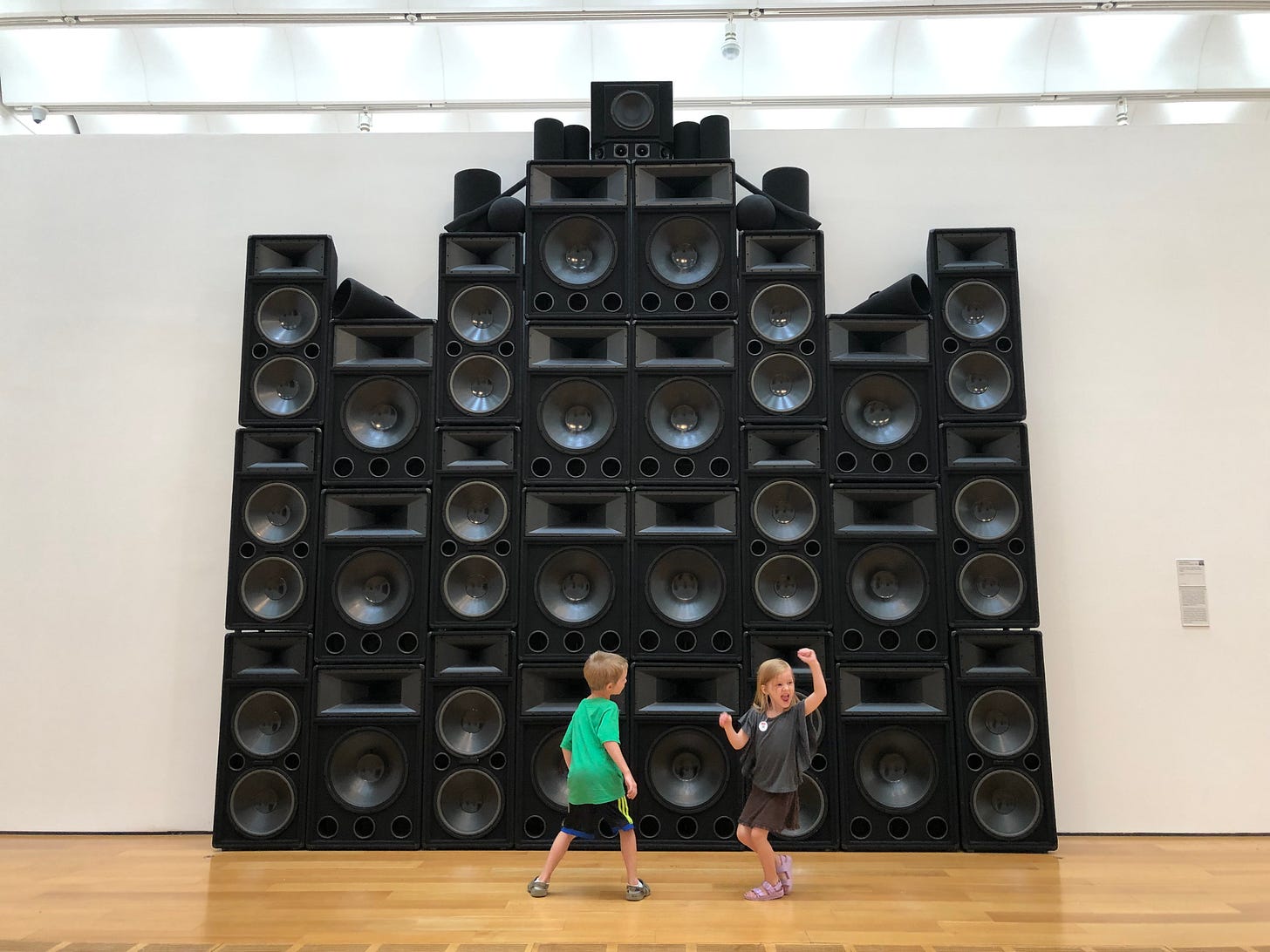Prepare yourself for some cute pictures of kids at museums 😉 This article is part advice, part travelogue, from the perspective of Hope, the founder of Family Scripts.
If you’re like me, you’ve spent a lot of your life thinking art museums were boring and pretentious. Mandatory field trips, snotty rich people, and actual artists who know how to appreciate it…is there another category of museum visitors?
It wasn’t until I visited the National Gallery of Art (the second time) that I really fell in love with art. And it wasn’t until I started listening to Russ Ramsey talk about art history that I fell in love with the artists themselves.
Here are some ways that art museums have impacted our family:
Art makes you feel. The first time I saw a Van Gogh painting in person, and every time since, I’ve been shocked by how it made me feel. It’s like I’m in the room with a suffering friend. I can sense his inner anguish so tangibly. His beautiful, pained art makes me have greater compassion for my suffering friends and, frankly, for myself in my own mental health struggles.
It’s fun to see what your kids are drawn to. My analytic son was entranced by the shapes of Cezanne. My dramatic daughter found great inspiration from Monet. My hands-on daughter appreciates interactive art displays the most. Or anything with monkeys. Their personalities shine through their artistic taste.
Your kids get to see you in awe. I’m happy that my kids have seen me in tears at a painting. I want them to believe that wonder doesn’t expire when you grow.
Acting dignified is good for them. They know they’re in the presence of greatness, and they act accordingly. There’s a time to be wild and silly—and we do plenty of that outdoors—but there’s a time to be careful and quiet and focus.
You never know what fun things they’ll have at a museum. There are numerous chances to have silly or grand moments that keep you childlike and really stick as memories.
Also, art changes culture. It’s a great way to talk about the stories and expressions of other people. Seeing and talking about art is a way to breach hard topics with beauty and nuance. Much of the best art is borne out of hardship, and it’s powerful to see that in person.
How to Visit Art Museums with Kids
In the appendices of this month’s book club pick, Russ Ramsey gives some awesome tips for visiting art museums and looking at art. But here are some tips for visiting art museums with kids:
Manage your expectations. You probably won’t be able to see everything. You won’t read every plaque. You’ll be passing up amazing pieces of art that probably deserve your attention but…you have limits. And that’s okay. Make the most of what you do see.
Teach your kids how to act in museums. There’s a time to be casual, and a time to be reverent. When artworks have been admired by millions of people for hundreds (or even thousands) of years, we need to be quiet so other people can admire them, too. We taught our kids a “museum posture” in which they either put their hands in their pockets or behind their backs. It’s the cutest thing. (I announce “museum posture!” when we’re in shops with breakable things, too 😉 )
No matter how old your kids are, they’ll remember interest more than facts. It’s important and helpful to teach them about the different periods in art, finding motifs, etc. But what’s even better than knowledge is inspiration. If your kids find an artist, art style, topic, historical period, etc. that interests them, they’ll want to study it on their own!
It’s okay to dislike some things. Once we went to a crowded museum that is devoted to a particular renowned artist, but I soon realized that his paintings made me feel troubled. I especially disliked all the paintings I saw of women. A quick search on his life showed much evidence that this man was greedy, he was a fascist, and he was disgusted by women. His art reflected all those things. That museum visit was an opportunity to tell the kids, “You know what? Some people are famous and even skillful, but that doesn’t mean their art is good. We don’t have to like things just because they’re popular.”
Give the kids extra chores so they can earn some souvenir money. Art museums tend to have gift shops with really great stuff. Overpriced, maybe, but it’s not the worst thing to support an art museum. My kids gladly slide $5 over the counter for a token to the Art-o-mat, which is a vending machine that dispenses handmade art.
Set out art supplies when you get home. You never know who will pick up the brush and try imitating something they saw at the museum!
How To Get Into Museums For Free!
One year, my family and I went to 28 different museums and botanical gardens. 28. Almost all of them were in the southeast—day trips from home or while visiting family in North Georgia. And almost all of those museum visits were free using a local museum pass that cost $100 for our whole family. The secret: reciprocal memberships.
Museums rarely rely on ticket prices alone to keep them going. They usually get help from private donors and from government grants. Most museums want foot traffic and engagement so they can prove to sponsors that this museum is educating the public in the ways it’s intended.
To increase foot traffic—and add perks to boost membership sales—they join a reciprocal network of museums. This means that if you have a pass to a museum in that network, you get free access to the other museums in that network. (Sometimes there are exceptions, such as you can’t visit a museum within a 90-mile radius of the museum you have a pass to.)
For example, a pass to the Edison and Ford Winter Estates in Fort Myers, FL, is $100 for a family. That’s not a small amount of money, especially if you don’t live anywhere near Florida. However, you don’t need to visit in-person—they mail the pass to you—and that glorious gold sticker on the back of it that says “NARM” instantly gets you access to a selection of 1,202 museums around North America. You simply walk up to the ticket counter of the museum that’s in that network, show your card, and they let you in for free. (If your schedule and budget are tight, you might want to call first to confirm that this will work.)
For example, one of my favorite places to visit is The Ringling in Sarasota, FL, but it’s $25 per adult. It would cost $65 for our family to visit! But I simply show my Edison and Ford Winter Estates pass, and we all get an enriching day at the gardens for $0.
Another great thing about the Edison and Ford Winter Estates pass is that it also includes reciprocal membership to the American Horticultural Society (AHS), which grants us entry into hundreds of botanical gardens around America. (It would normally cost our family $138 to get into the Atlanta Botanical Gardens, but we flashed our Edison pass and it was $0.)
There are other reciprocal memberships, too. The ASTC opens the door for a lot of children’s museums and science museums. AZA gives you half off at some zoos and aquariums. Sometimes there are regional reciprocal programs, such as the SERM for the Southeast.
All that to say, check the cards in your wallet. Do you have a membership to your local science museum? Examine the card (or check the museum’s website.) If it says ASTC on it, check out the ASTC website and see what museums might be en route on your summer vacation. If you don’t have any passes, consider investing in one!
My favorite family passes and their prices for family memberships are:
Edison and Ford Winter Estates (NARM, AHS, and Time Travelers) - $100
River Discovery Center (ASTC, SERM) - $100
Western North Carolina Nature Center (ASTC and AZA) - $89
I’m happy to pay for a pass to a local museum, and I’m happy to use the reciprocal benefits that they offer. These institutions want people to have access to museums and gardens. Take them up on it 😉
Hopefully this was helpful! Have a great weekend!
Warmly,
Hope from Family Scripts














We love our passes!!! It definitely makes traveling fun when we can squeeze in a free outing!!!!! Love this post!!!
LOVE this post, Hope -- such great advice. My parents took me to many art (and other) museums as a kid, and as such, I never really grew up with the attitude that they were boring and pretentious. (My husband says, "You're a museum person," and it's true, but it wouldn't be true if I hadn't been raised that way, probably.)
Another way to get in for free is to check the rewards on your credit cards. Many offer free entrance or discounted prices to museums and aquariums around the country. Also worth mentioning military discounts -- many museums offer them to veterans in addition to those on active duty (even if you're just saving money on one ticket, one discounted ticket makes a difference when the total bill is $$$!)